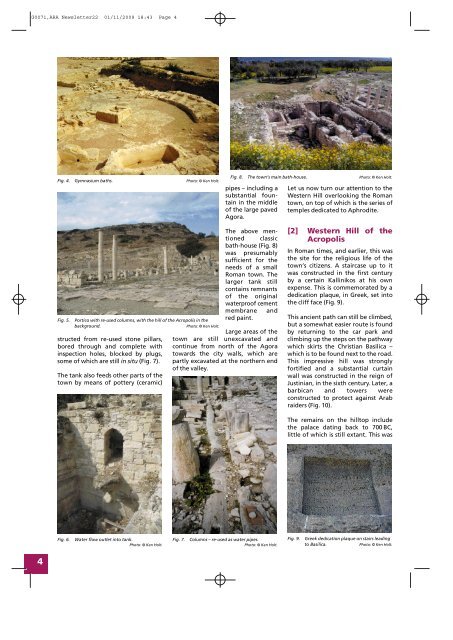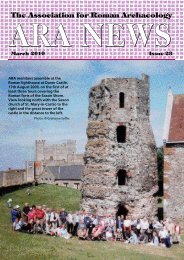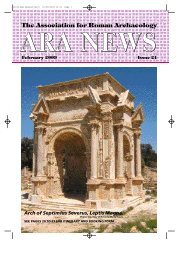Newsletter Issue 22 - Association for Roman Archaeology
Newsletter Issue 22 - Association for Roman Archaeology
Newsletter Issue 22 - Association for Roman Archaeology
You also want an ePaper? Increase the reach of your titles
YUMPU automatically turns print PDFs into web optimized ePapers that Google loves.
G0071,ARA <strong>Newsletter</strong><strong>22</strong> 01/11/2009 18:43 Page 4Fig. 4. Gymnasium baths. Photo: © Ken Holt.Fig. 8. The town’s main bath-house. Photo: © Ken Holt.pipes – including asubstantial fountainin the middleof the large pavedAgora.Let us now turn our attention to theWestern Hill overlooking the <strong>Roman</strong>town, on top of which is the series oftemples dedicated to Aphrodite.Fig. 5.Portico with re-used columns, with the hill of the Acropolis in thebackground.Photo: © Ken Holt.structed from re-used stone pillars,bored through and complete withinspection holes, blocked by plugs,some of which are still in situ (Fig. 7).The tank also feeds other parts of thetown by means of pottery (ceramic)The above mentionedclassicbath-house (Fig. 8)was pre s u m a b l ysufficient <strong>for</strong> theneeds of a small<strong>Roman</strong> town. Thel a rger tank stillcontains remnantsof the originalw a t e r p roof cementmembrane andred paint.Large areas of thetown are still unexcavated andcontinue from north of the Agoratowards the city walls, which arepartly excavated at the northern endof the valley.[2] Western Hill of theAcropolisIn <strong>Roman</strong> times, and earlier, this wasthe site <strong>for</strong> the religious life of thetown’s citizens. A staircase up to itwas constructed in the first centuryby a certain Kallinikos at his ownexpense. This is commemorated by adedication plaque, in Greek, set intothe cliff face (Fig. 9).This ancient path can still be climbed,but a somewhat easier route is foundby returning to the car park andclimbing up the steps on the pathwaywhich skirts the Christian Basilica –which is to be found next to the road.This impressive hill was stro n g l y<strong>for</strong>tified and a substantial curtainwall was constructed in the reign ofJustinian, in the sixth century. Later, abarbican and towers wereconstructed to protect against Arabraiders (Fig. 10).The remains on the hilltop includethe palace dating back to 700 BC,little of which is still extant. This wasFig. 6.Water flow outlet into tank.Photo: © Ken Holt.Fig. 7.Columns – re-used as water pipes.Photo: © Ken Holt.Fig. 9.Greek dedication plaque on stairs leadingto Basilica.Photo: © Ken Holt.4




